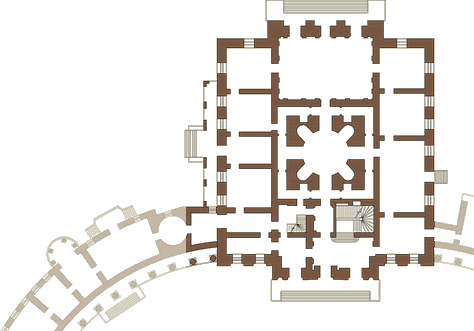The Raspberry Study
Загрузка панорамы...
According to the original project of Charles Cameron, four rooms were at the current place of the Raspberry Study, separated by partitions: the Study, the Valet's Room, and two dark rooms (without windows), probably intended as a clothes room and a dressing room. Only when Paul I ascended to the throne and Pavlovsk became an imperial residence, architect Vincenzo Brenna completely reworked these rooms. By removing the partitions, he created a spacious personal study for the Emperor, called Raspberry Study after the color of the window draperies and upholstery of furniture. Sofa and armchairs of carved gilded wood are upholstered in the 18th-century raspberry Russian decorative fabric. The decoration is distinguished by utmost simplicity and severity: plastered walls painted with glue paint and adorned with a classic stucco cornice. A bronze and glass lantern with crystal decor illuminates the place: a typical example of Russian lighting devices of the second half of the 18th century.
The 18th-century furniture masterpieces occupy a special place in the Study, made by David Roentgen, an outstanding cabinetmaker and the creator of new forms of study furniture, hailing from the German city of Neuwied. In 1784, Empress Catherine II ordered a large batch of furniture from the Roentgen's workshop for the decoration of the Pavlovsk Palace, the residence of her son, Grand Duke Pavel Petrovich. To the right, against the wall, there is an elegant multi-stage mahogany bureau with gilded bronze overlays. In the center, there is a superstructure cabinet with a curtain-shaped door for storing papers and documents. Double gilded columns decorate its sides, topped by a frieze ribbon with gold rosettes. On the top of this cabinet, there is a biscuit porcelain sculpture of St. Mary Magdalene (Meissen porcelain manufactory, the 1780s). An Inscription in golden letters on white porcelain states that the theme originates from a painting by Pompeo Battoni. A classic rectangular table on faceted legs with wheels (for ease of movement) stands in the center of the study. It belongs to the transforming furniture type, a new invention of Roentgen: it has three tabletops for playing cards, checkers, and backgammon. Paul I enjoyed board games and was an excellent chess player. In the right corner of the study, there is a tall three-tiered mahogany grandfather clock with clear architectural proportions. The lowest part, shaped like a classic podium with thin bronze overlays, was intended to house a complex clockwork mechanism. The middle, most elegant part, is decorated as a portico with a pediment. Its side corners are decorated as term figures with bronze gilded heads supporting the cornice and the pediment. A fine gilded frieze is located under the cornice, resembling Classical Greek art. A clock dial is depicted in the central part against a shiny golden plate background; it is surrounded with a braided wreath and strenuously supported by Saturn Devouring Time, made from gilded bronze in the technique of high relief. A two-tiered attic rises above the cornice, surrounded by a balustrade with vases at its corners. The figure of Apollo, the patron of the arts, stands at the top. Working on the artistic shell of the clock, David Roentgen actively collaborated with mechanic Peter Kinzig, who made a musical mechanism for this clock; it performed melodies for the organ and harpsichord.
Picturesque views of the Pavlovsk Park of the late 18th–early 19th centuries decorate the study walls. On the central wall is a panoramic landscape View of the Pavlovsk Palace and the Marienthal Pond by Semyon Shchedrin (1800), the first Russian landscape painter. In the 19th century, the painting was cut into two parts. During the restoration of both parts, they were enclosed in a single frame with a thin lintel in the center, depicting the landscapes along the banks of the Slavyanka River just as the artist saw them at the turn of the 18th and 19th centuries. In 2016, the painting took its permanent place in the Raspberry Study.
The Study has paintings by Andrey Martynov, another famous Russian landscape painter, a student and follower of Semyon Shchedrin. Above the bureau, there is the View of the Pavlovsk Palace (1815), and above the fireplace, there are two landscapes of the Pavlovsk Park: Temple of Friendship and Pill Tower (the late 18th–early 19th centuries).
A set of original porcelain candelabra vases of the Sèvres manufactory (the 1780s) adorns the mantelpiece. The window slope is decorated with a mosaic representing a view of the Colosseum in an elegant bronze frame topped with an image of the papal tiara. It was performed by master Cesare Aguatti in the technique of Roman mosaic, using cobalt glass. Pope Pius VI presented this mosaic to Grand Duke Pavel Petrovich in 1782, when he was granted an audience with the Pope in the Vatican. According to the inventory of 1805, there is a “white carved marble bouquet in a round frame” above the mirror, between the windows.
In 1858, the Study was adapted for the bedroom of Grand Duke Konstantin Nikolaevich and his wife Alexandra Iosifovna. It was decorated in the style of Louis XV. After the war, the Study was restored according to the projects and descriptions of the early 19th century.
The Raspberry Study on the floor plane
- The Raspberry Study
- The Common Study
- The New Study
- The Corner Drawing Room
- The White Dining Room
- The Billiards Room
- The Old Drawing Room
- The Ball Room
- The French Room
- The Dark Pantry

Back
